|
Click pictures for a larger version.
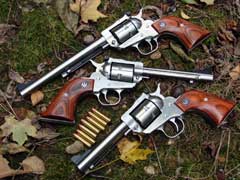
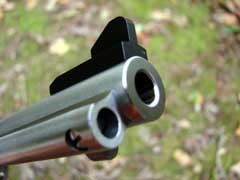
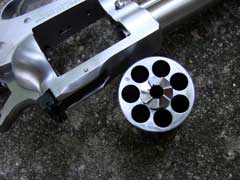
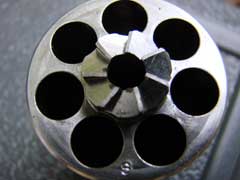
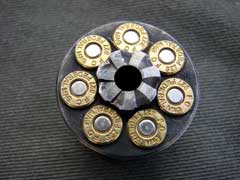
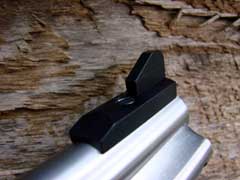
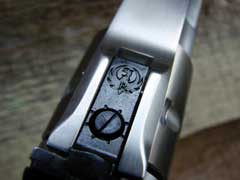

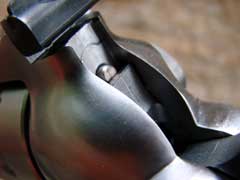
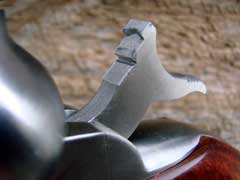
Transfer bar safety allows the Single-Seven to be carried fully-loaded.
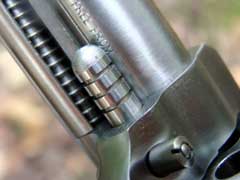
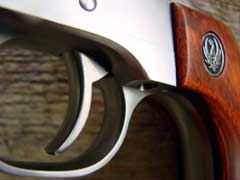
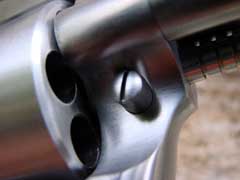
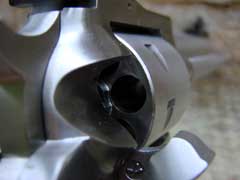
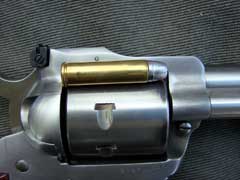
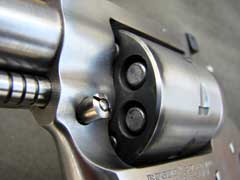
Cylinder is plenty long enough to handle 130-grain Buffalo Bore
ammunition.
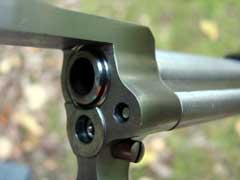
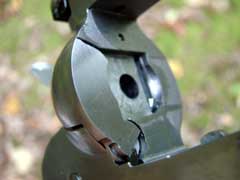


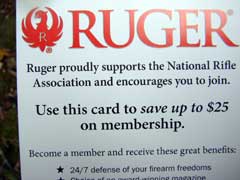

|
|
It has been almost seven years now since
Ruger and Federal Cartridge introduced the dandy little 327
Federal Magnum cartridge. Chambered in the toughest little
small-frame revolver ever built, the Ruger
SP-101, the 327 Federal was (and still is) and excellent
defensive round in an easy-to-conceal compact revolver. Smith
& Wesson and Charter
Arms soon followed with compact revolvers chambered for the
327 Federal Magnum cartridge.
A couple of years later, Freedom
Arms chambered their superb Model 97 single-action revolver
for the 327, and Ruger also introduced
their Blackhawk and GP-100 full-sized revolvers for the
cartridge. Freedom Arms still has their Model 97 chambered for
the 327, but the GP-100 and Blackhawk are no longer listed for
the cartridge. S&W still lists their 632, but I can find
none in stock listed at any of the major distributors at this
time.
A couple of years ago, Ruger held a
conference dealing with the topic of single action revolvers,
and invited about three writers, a top-tier custom gunsmith,
experts in firearm distribution, and a couple of other
interested parties. We sat in a conference room with Ruger
engineers and executives, from the CEO on down, and we discussed
the topic of revolvers for a couple of days. With gun
manufacturers, including Ruger, running wide open for the past
couple of years, there are only two guns to come out of that
meeting so far, but others are on the way and cannot be
discussed at this time. The first revolver to be introduced as a
result of that conference was the Bearcat
Shopkeeper, and the other is the new Single-Seven shown
here.
At that conference, the feasibility of
chambering the 327 in the Single-Six frame was a topic of
discussion, and with the new Single-Seven, Ruger has greatly
exceeded my expectations. Ruger engineers managed to fit the
cartridge into that small frame with enough cylinder length to
chamber even heavy-for-caliber cast bullets, in addition to
every commercial loading available. Also, they fitted in seven
chambers instead of six. The chambers line up perfectly with the
loading gate for loading and unloading. Ruger offers the
Single-Seven in three barrel lengths; 4.625, 5.5, and 7.5
inches. The Single-Seven is built of stainless steel, and has an
adjustable rear sight mated to a ramped front, the latter of
which is screwed atop the barrel, for easy replacement if
desired. The revolver is fitted with great-looking wood grips,
which fit my hand very well.
Specification for the Single-Seven are listed
below. Weight is listed in ounces. Linear measurements are
listed in inches. Height includes the adjustable rear sight, set
to its intermediate position. Trigger pulls are listed as pounds
of resistance, as measured with a Lyman digital trigger pull
gauge.
| Barrel Length |
4.625 inches |
5.5 inches |
7.5 inches |
| Overall Length |
10.125 inches |
11 inches |
13 inches |
| Overall Height |
5.06 inches |
5.06 inches |
5.06 inches |
| Weight Unloaded |
35.2 ounces |
35.8 ounces |
38 ounces |
| Cylinder Length |
1.45 inches |
1.45 inches |
1.45 inches |
| Cylinder Diameter |
1.418 inches |
1.418 inches |
1.418 inches |
| Barrel / Cylinder Gap |
0.004 inch |
0.006 inch |
0.006 inch |
| Trigger Pull, As Delivered |
3.25 pounds |
3.4 pounds |
3.41 pounds |
| MSRP, as of October 2014 |
$659.00 US |
$659.00 US |
$659.00 US |
I
fired a variety of 327 Magnum factory loads to check for
velocity with each of the three revolvers of differing barrel
lengths, to see how much, if any, the velocities were affected
by the length of the barrel. Velocities are listed in the chart
below, and are listed in feet-per-second (FPS), as recorded ten
feet from the muzzle of the Single-Seven revolvers. LSWC is a
hard-cast lead semi-wadcutter bullet. JHP is a jacketed
hollowpoint. JSP is a jacketed hollowpoint bullet. HCL and LFP
are lead bullets. Bullet weights are listed in grains.
Velocities were recorded at 541 feet above sea level, with an
air temperature of sixty-six degrees, and a humidity in the
eighty-two percent range. I also fired the Single-Seven
revolvers with 32 H&R, 32 S&W Long, and 32 ACP
ammunition, with the results listed below.
| Ammunition |
Bullet Weight |
Velocity 4.625" |
Velocity 5.5" |
Velocity 7.5" |
327 Federal Magnum
|
|
|
|
|
| Buffalo Bore LSWC |
130 |
1340 |
1369 |
1320 |
| Buffalo Bore JHP |
100 |
1364 |
1430 |
1335 |
| American Eagle JSP |
100 |
1517 |
1529 |
1496 |
| American Eagle JSP |
85 |
1325 |
1366 |
1346 |
| Speer JHP |
115 |
1419 |
1491 |
1382 |
| Speer JHP |
100 |
1550 |
1591 |
1476 |
32 H&R Magnum
|
|
|
|
|
| Buffalo Bore JHP |
100 |
1228 |
1253 |
1216 |
| Buffalo Bore HCL |
130 |
1067 |
1076 |
1053 |
| Black Hills LFP |
90 |
792 |
776 |
734 |
32 S&W Long
|
|
|
|
|
| Buffalo Bore HCL |
115 |
791 |
800 |
755 |
32 ACP
|
|
|
|
|
| Cor-Bon JHP |
60 |
911 |
948 |
875 |
As can be seen from the velocity chart above,
a longer barrel does not automatically equate to higher
velocities. In this case, the longer barrel was the slowest of
all three revolvers, sometimes by a large margin. I expected the
4-5/8 inch barrel to achieve higher velocities than the 5-1/2
inch barrel, as the short gun had the tightest barrel/cylinder
gap, but my expectations were unfounded. The 5-1/2 inch gun
consistently achieved the highest velocities, with almost every
load tested. This proves that one cannot reliably make
assumptions regarding barrel length and velocity without testing
the weapons.
For accuracy testing, I secured each revolver
into my Ransom Master Series machine
rest, to eliminate as much human error as possible. All
accuracy testing was done at a distance of twenty-five yards.
Reliability was perfect in all three revolvers, with all ammo
tested. I could discern no accuracy differences between the
three revolvers. Each turned in very good accuracy, as well as
mediocre accuracy, depending upon the ammunition tested. This is
evidence that if a handgun or rifle will not shoot accurately,
one should always try different ammunition.
I have high hopes for the success of the
Single-Seven revolver, and ultimately that of the 327 Federal
Magnum cartridge. I would love to see the introduction of a
handy little lever-action carbine chambered for the cartridge,
and hopefully, Marlin or another company will deliver on that,
but for now, if anything is going to save and revive this
excellent little 32 caliber cartridge, I think it will be the
Single-Seven. While the 327 is a good little defensive round, I
also see it as a very good hunting and general purpose revolver
cartridge, and hopefully, it will gain in popularity, serving us
in the same role that the 32 WCF (32-20) served our
great-grandfathers around the turn of the previous century.
The Ruger Single-Seven revolvers are very
well fitted and finished, and like all Ruger firearms, they are
built in the USA.
The Ruger Single-Seven is a distributor
exclusive, and is available only from Lipsey's, so for the
location of a Lipsey's dealer near you, click on the DEALER
FINDER at www.lipseys.com.
To order quality 327 Federal Magnum
ammunition, go to www.buffalobore.com,
www.midsouthshooterssupply.com,
and www.luckygunner.com.
For
a closer look at the entire line of Ruger firearms and
accessories, go to www.ruger.com
Jeff Quinn
  
Got something to say about this article?
Want to agree (or disagree) with it? Click the following link to
go to the GUNBlast Feedback Page.
|
|
Click pictures for a larger version.
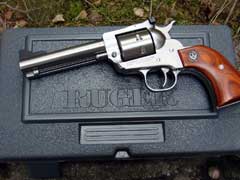
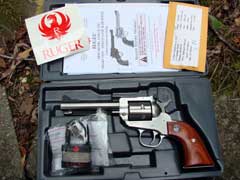
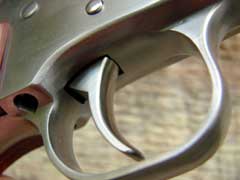
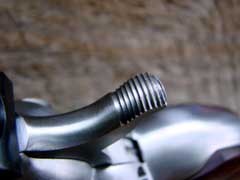

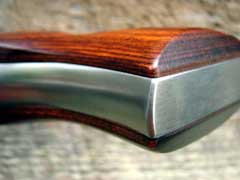
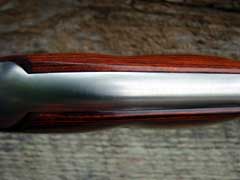
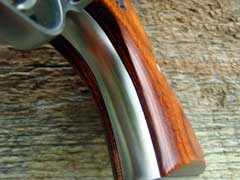
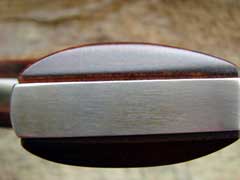
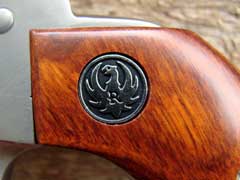
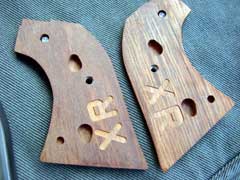
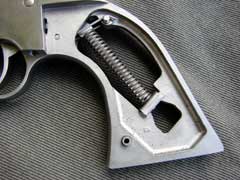
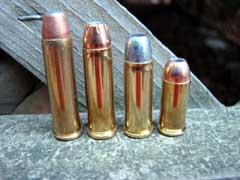
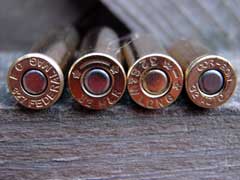
Author tested the Single-Seven revolvers with (left to right): 327 Federal
Magnum, 32 H&R Magnum, 32 S&W Long, and 32 ACP ammunition.

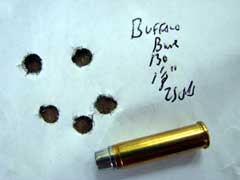
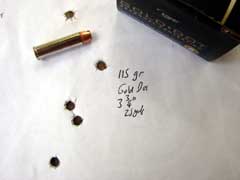
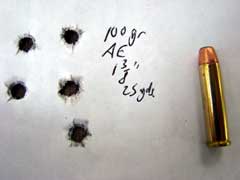
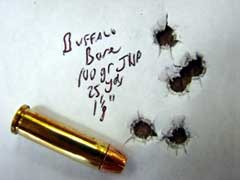


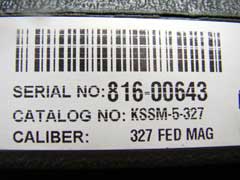
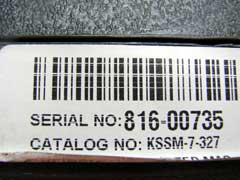
|
![]()